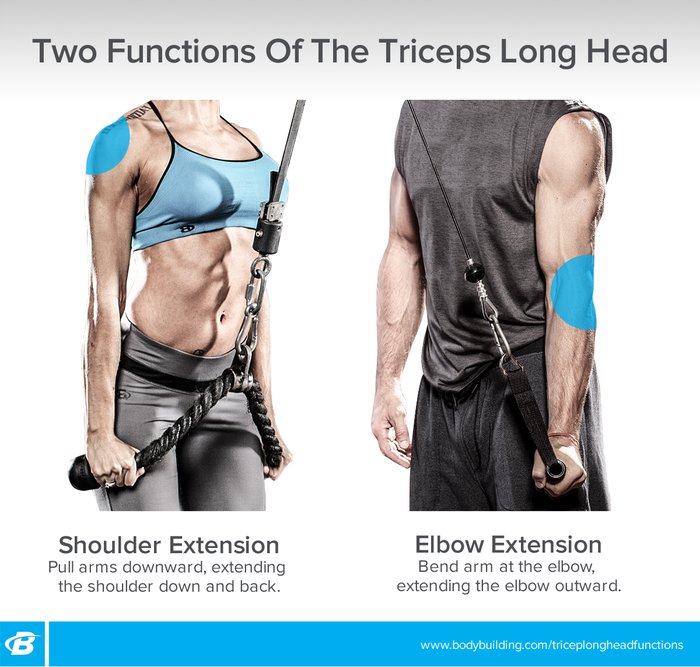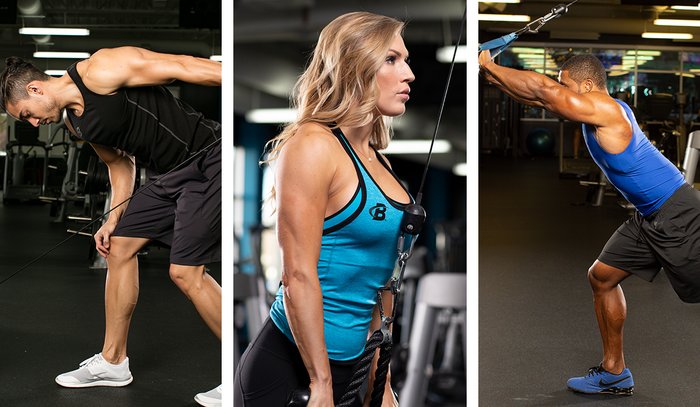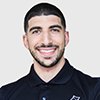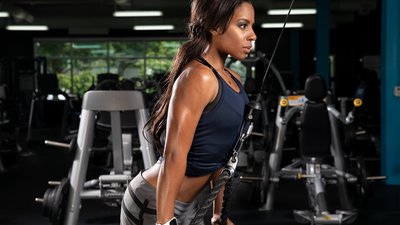You can't have strong, defined arms without dedicating time and effort to training your triceps. The problem is most lifters don't really understand how to integrate the different heads of the triceps—and plenty of those who think they do have been misinformed.
Do I have your attention? Let's get all three heads in the game.
How the triceps really work
The primary function of all three heads of the triceps brachii is elbow extension—that much you know. And when you do the most popular triceps movements like close-grip bench, push-downs, or skullcrushers, you're training that motion.
However, the long head of the triceps crosses the shoulder joint, which means it is also responsible (along with the lats and a few smaller muscles) for extending the shoulder. This is why shoulder position makes a difference when training your triceps. Your shoulder position influences how the tension is distributed across the muscle, forcing certain heads of the triceps to do the majority of the work.

Tell me if you've heard this one: "If you want to target the long head of the triceps, you have to do 'overhead' variations." If your answer is yes, you're wrong—and you're not alone. Many athletes, coaches, and trainers still believe overhead variations are the only way to target the long head of the triceps, and they are more than happy to pass their mistaken triceps knowledge along to other lifters.
While overhead extension variations do put the long head of the triceps in an extreme lengthened (stretched) position, which can put a lot of stress and tension on the muscle, this lengthened position actually inhibits the long head from concentrically contracting. This means when you're doing overhead triceps extensions, the medial and lateral heads are actually doing the vast majority of the work!
This is due to the length-tension relationship, a law every muscle follows. All muscles are strongest and produce the greatest amount of force when they're in the middle of their range. However, when a muscle is in a shortened position or a lengthened position—as the long head is in the overhead position—its ability to create force is significantly inhibited, making it weak in these extreme ends of the range.

Putting triceps training to the test
Utilizing the electromyography (EMG) technology in the Human Performance Lab at the University of Tampa, I am able to demonstrate how different variations of triceps extension affect the muscle.
As you can see, the long head of the triceps achieves significantly greater activation during cable triceps push-downs when I finish the movement by extending the shoulder back, or pulling the arms closer to the body. This small addition (seriously, it's just a few extra inches) should become a normal part of how you perform the push-down.
Another exercise I highly recommend for targeting the triceps long head is the cable kick-back. This movement is most commonly performed with dumbbells, but they're less than ideal, because the exercise only becomes challenging at the end of the range of motion. I'd suggest utilizing the cable column or a resistance band instead, to create even resistance throughout the entire range of motion.
How to select the best exercises to train your arms
Don't get me wrong, although the long head of the triceps isn't getting a lot of activation when performing the overhead triceps press, I still recommend you include this exercise in your training regimen. By placing your triceps in such an extreme stretched position, this exercise has the potential to create a significant amount of muscle damage during the eccentric contraction.
However, muscle damage is only one key mechanism for increasing muscle sizes. You need strong concentric work, too! So yes, the overhead variation does have a place in your triceps routine, but not for the reason you think. It is a great way to force the medial and lateral heads to do a lot of the concentric work, while doing damage to the long head. But for long-head activation, look elsewhere.

You don't need a ton of variation in your triceps program, but you do need exercises that hit each head and force the muscle group to work in different ranges. I recommend using 2-3 exercises that each provide different stimuli to promote strength and size gains in every area of your triceps:
- One exercise with your shoulder extended (e.g., cable triceps kick-back).
- One exercise with your shoulder neutral (e.g., cable triceps push-down with extra shoulder extension).
- One exercise with your shoulder flexed (e.g., overhead triceps extension).
Before you ask me in the comments, yes, you can and should take the same approach when training biceps:
- One exercise with your shoulder extended (e.g., incline dumbbell curl).
- One exercise with your shoulder neutral (e.g., standing curl variation).
- One exercise with your shoulder flexed (e.g., spider curl).
You can also check out my previous article utilizing the EMG in the lab to optimize your spider curl technique.
Give these exercises a shot and let the arm gains begin!



